Business Decision Making Report: Market, Customer, and Data Analysis
VerifiedAdded on 2020/01/28
|20
|4892
|110
Report
AI Summary
This report delves into the intricacies of business decision-making, utilizing a case study of Thomas Cook to illustrate key concepts. The report begins by identifying sources of primary and secondary data, followed by an exploration of survey methodology, including sampling techniques and questionnaire design. Statistical summaries of data are then presented, alongside data analysis using dispersion measures, quartiles, percentiles, and correlation coefficients. The report further examines data visualization through graphs and trend line charts, culminating in the development of a business presentation and a formal business report. Finally, the use of information processing and financial tools is discussed to provide a comprehensive overview of the decision-making process. The report emphasizes practical application, with a focus on market and customer trend analysis to inform strategic decisions.
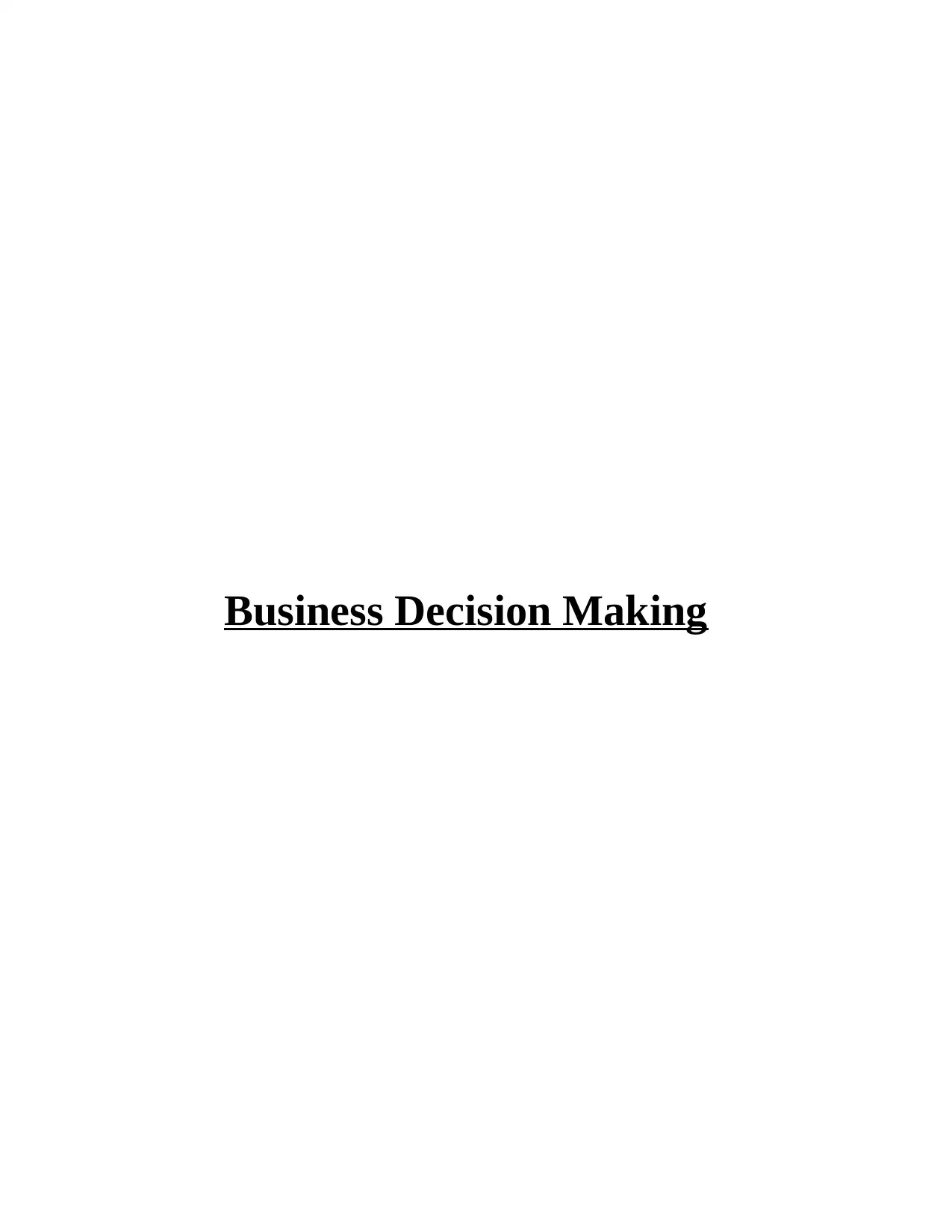
Business Decision Making
Paraphrase This Document
Need a fresh take? Get an instant paraphrase of this document with our AI Paraphraser
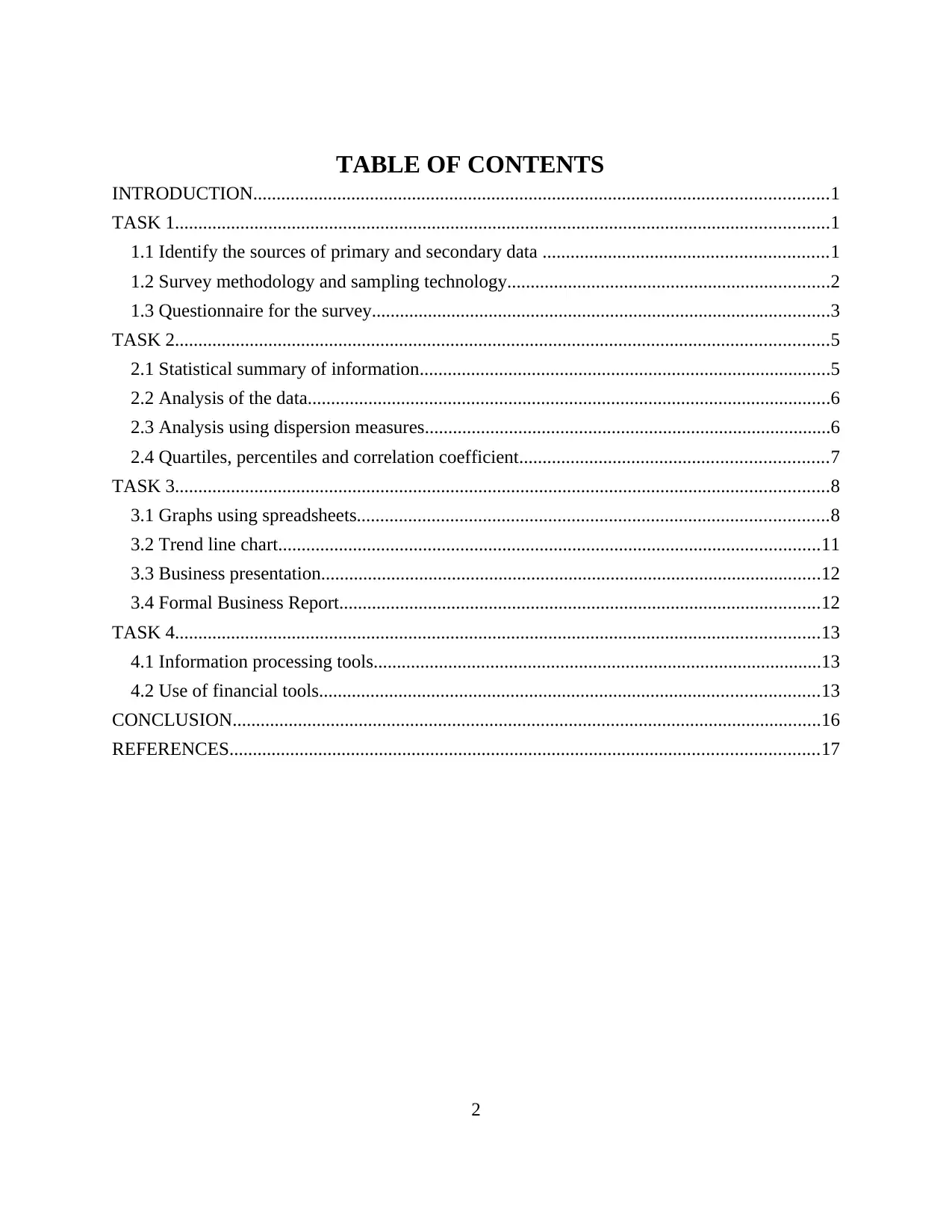
TABLE OF CONTENTS
INTRODUCTION...........................................................................................................................1
TASK 1............................................................................................................................................1
1.1 Identify the sources of primary and secondary data .............................................................1
1.2 Survey methodology and sampling technology.....................................................................2
1.3 Questionnaire for the survey..................................................................................................3
TASK 2............................................................................................................................................5
2.1 Statistical summary of information........................................................................................5
2.2 Analysis of the data................................................................................................................6
2.3 Analysis using dispersion measures.......................................................................................6
2.4 Quartiles, percentiles and correlation coefficient..................................................................7
TASK 3............................................................................................................................................8
3.1 Graphs using spreadsheets.....................................................................................................8
3.2 Trend line chart....................................................................................................................11
3.3 Business presentation...........................................................................................................12
3.4 Formal Business Report.......................................................................................................12
TASK 4..........................................................................................................................................13
4.1 Information processing tools................................................................................................13
4.2 Use of financial tools...........................................................................................................13
CONCLUSION..............................................................................................................................16
REFERENCES..............................................................................................................................17
2
INTRODUCTION...........................................................................................................................1
TASK 1............................................................................................................................................1
1.1 Identify the sources of primary and secondary data .............................................................1
1.2 Survey methodology and sampling technology.....................................................................2
1.3 Questionnaire for the survey..................................................................................................3
TASK 2............................................................................................................................................5
2.1 Statistical summary of information........................................................................................5
2.2 Analysis of the data................................................................................................................6
2.3 Analysis using dispersion measures.......................................................................................6
2.4 Quartiles, percentiles and correlation coefficient..................................................................7
TASK 3............................................................................................................................................8
3.1 Graphs using spreadsheets.....................................................................................................8
3.2 Trend line chart....................................................................................................................11
3.3 Business presentation...........................................................................................................12
3.4 Formal Business Report.......................................................................................................12
TASK 4..........................................................................................................................................13
4.1 Information processing tools................................................................................................13
4.2 Use of financial tools...........................................................................................................13
CONCLUSION..............................................................................................................................16
REFERENCES..............................................................................................................................17
2
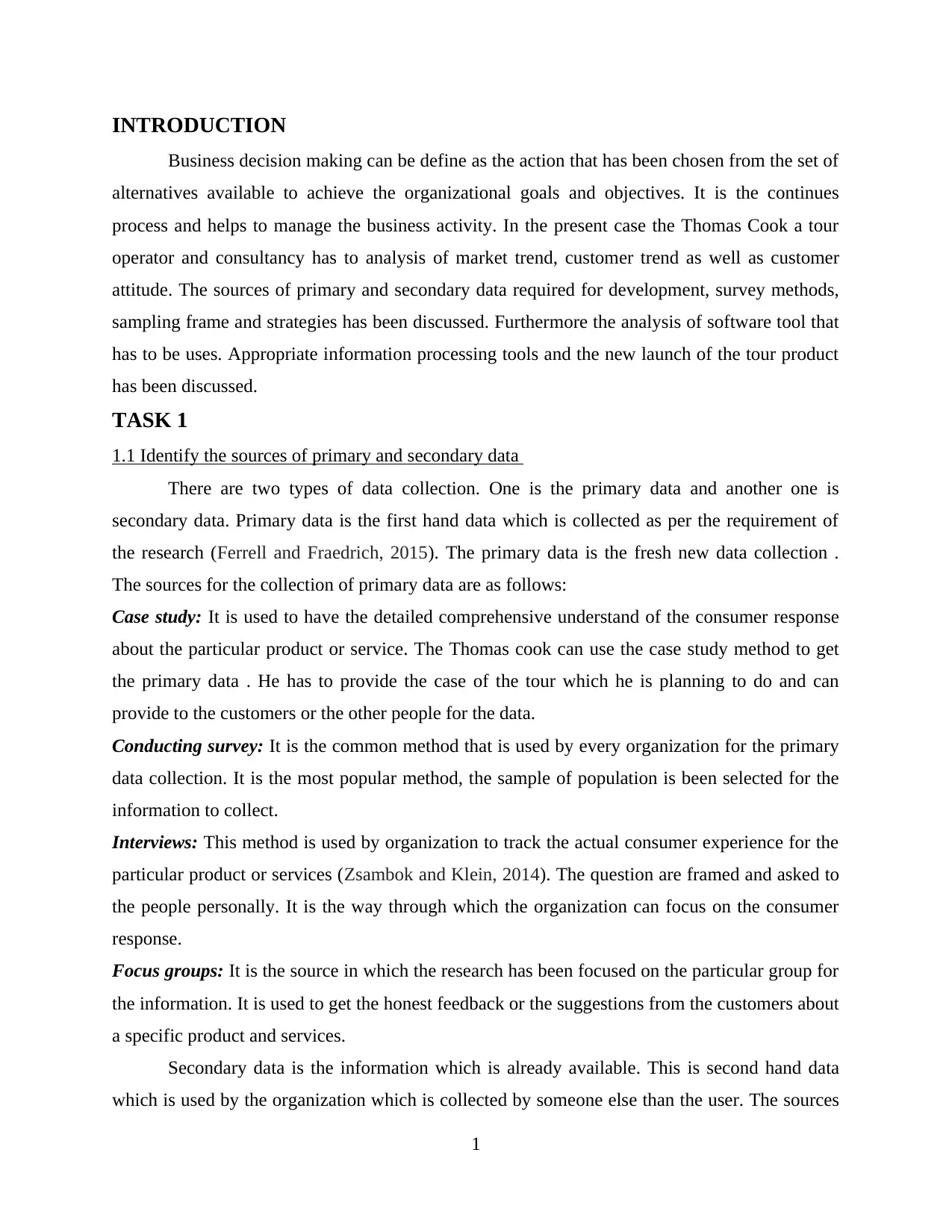
INTRODUCTION
Business decision making can be define as the action that has been chosen from the set of
alternatives available to achieve the organizational goals and objectives. It is the continues
process and helps to manage the business activity. In the present case the Thomas Cook a tour
operator and consultancy has to analysis of market trend, customer trend as well as customer
attitude. The sources of primary and secondary data required for development, survey methods,
sampling frame and strategies has been discussed. Furthermore the analysis of software tool that
has to be uses. Appropriate information processing tools and the new launch of the tour product
has been discussed.
TASK 1
1.1 Identify the sources of primary and secondary data
There are two types of data collection. One is the primary data and another one is
secondary data. Primary data is the first hand data which is collected as per the requirement of
the research (Ferrell and Fraedrich, 2015). The primary data is the fresh new data collection .
The sources for the collection of primary data are as follows:
Case study: It is used to have the detailed comprehensive understand of the consumer response
about the particular product or service. The Thomas cook can use the case study method to get
the primary data . He has to provide the case of the tour which he is planning to do and can
provide to the customers or the other people for the data.
Conducting survey: It is the common method that is used by every organization for the primary
data collection. It is the most popular method, the sample of population is been selected for the
information to collect.
Interviews: This method is used by organization to track the actual consumer experience for the
particular product or services (Zsambok and Klein, 2014). The question are framed and asked to
the people personally. It is the way through which the organization can focus on the consumer
response.
Focus groups: It is the source in which the research has been focused on the particular group for
the information. It is used to get the honest feedback or the suggestions from the customers about
a specific product and services.
Secondary data is the information which is already available. This is second hand data
which is used by the organization which is collected by someone else than the user. The sources
1
Business decision making can be define as the action that has been chosen from the set of
alternatives available to achieve the organizational goals and objectives. It is the continues
process and helps to manage the business activity. In the present case the Thomas Cook a tour
operator and consultancy has to analysis of market trend, customer trend as well as customer
attitude. The sources of primary and secondary data required for development, survey methods,
sampling frame and strategies has been discussed. Furthermore the analysis of software tool that
has to be uses. Appropriate information processing tools and the new launch of the tour product
has been discussed.
TASK 1
1.1 Identify the sources of primary and secondary data
There are two types of data collection. One is the primary data and another one is
secondary data. Primary data is the first hand data which is collected as per the requirement of
the research (Ferrell and Fraedrich, 2015). The primary data is the fresh new data collection .
The sources for the collection of primary data are as follows:
Case study: It is used to have the detailed comprehensive understand of the consumer response
about the particular product or service. The Thomas cook can use the case study method to get
the primary data . He has to provide the case of the tour which he is planning to do and can
provide to the customers or the other people for the data.
Conducting survey: It is the common method that is used by every organization for the primary
data collection. It is the most popular method, the sample of population is been selected for the
information to collect.
Interviews: This method is used by organization to track the actual consumer experience for the
particular product or services (Zsambok and Klein, 2014). The question are framed and asked to
the people personally. It is the way through which the organization can focus on the consumer
response.
Focus groups: It is the source in which the research has been focused on the particular group for
the information. It is used to get the honest feedback or the suggestions from the customers about
a specific product and services.
Secondary data is the information which is already available. This is second hand data
which is used by the organization which is collected by someone else than the user. The sources
1
⊘ This is a preview!⊘
Do you want full access?
Subscribe today to unlock all pages.

Trusted by 1+ million students worldwide
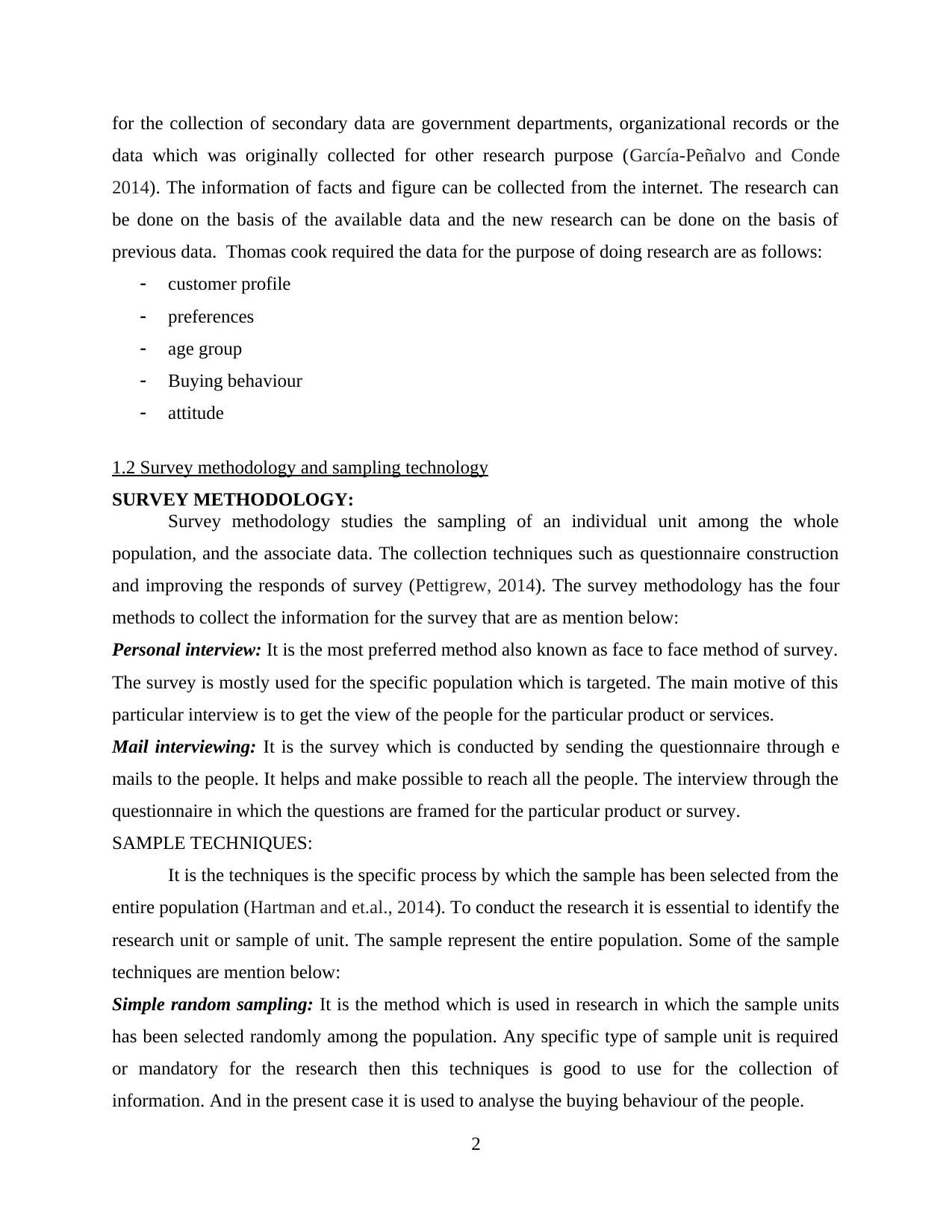
for the collection of secondary data are government departments, organizational records or the
data which was originally collected for other research purpose (García-Peñalvo and Conde
2014). The information of facts and figure can be collected from the internet. The research can
be done on the basis of the available data and the new research can be done on the basis of
previous data. Thomas cook required the data for the purpose of doing research are as follows:
customer profile
preferences
age group
Buying behaviour
attitude
1.2 Survey methodology and sampling technology
SURVEY METHODOLOGY:
Survey methodology studies the sampling of an individual unit among the whole
population, and the associate data. The collection techniques such as questionnaire construction
and improving the responds of survey (Pettigrew, 2014). The survey methodology has the four
methods to collect the information for the survey that are as mention below:
Personal interview: It is the most preferred method also known as face to face method of survey.
The survey is mostly used for the specific population which is targeted. The main motive of this
particular interview is to get the view of the people for the particular product or services.
Mail interviewing: It is the survey which is conducted by sending the questionnaire through e
mails to the people. It helps and make possible to reach all the people. The interview through the
questionnaire in which the questions are framed for the particular product or survey.
SAMPLE TECHNIQUES:
It is the techniques is the specific process by which the sample has been selected from the
entire population (Hartman and et.al., 2014). To conduct the research it is essential to identify the
research unit or sample of unit. The sample represent the entire population. Some of the sample
techniques are mention below:
Simple random sampling: It is the method which is used in research in which the sample units
has been selected randomly among the population. Any specific type of sample unit is required
or mandatory for the research then this techniques is good to use for the collection of
information. And in the present case it is used to analyse the buying behaviour of the people.
2
data which was originally collected for other research purpose (García-Peñalvo and Conde
2014). The information of facts and figure can be collected from the internet. The research can
be done on the basis of the available data and the new research can be done on the basis of
previous data. Thomas cook required the data for the purpose of doing research are as follows:
customer profile
preferences
age group
Buying behaviour
attitude
1.2 Survey methodology and sampling technology
SURVEY METHODOLOGY:
Survey methodology studies the sampling of an individual unit among the whole
population, and the associate data. The collection techniques such as questionnaire construction
and improving the responds of survey (Pettigrew, 2014). The survey methodology has the four
methods to collect the information for the survey that are as mention below:
Personal interview: It is the most preferred method also known as face to face method of survey.
The survey is mostly used for the specific population which is targeted. The main motive of this
particular interview is to get the view of the people for the particular product or services.
Mail interviewing: It is the survey which is conducted by sending the questionnaire through e
mails to the people. It helps and make possible to reach all the people. The interview through the
questionnaire in which the questions are framed for the particular product or survey.
SAMPLE TECHNIQUES:
It is the techniques is the specific process by which the sample has been selected from the
entire population (Hartman and et.al., 2014). To conduct the research it is essential to identify the
research unit or sample of unit. The sample represent the entire population. Some of the sample
techniques are mention below:
Simple random sampling: It is the method which is used in research in which the sample units
has been selected randomly among the population. Any specific type of sample unit is required
or mandatory for the research then this techniques is good to use for the collection of
information. And in the present case it is used to analyse the buying behaviour of the people.
2
Paraphrase This Document
Need a fresh take? Get an instant paraphrase of this document with our AI Paraphraser
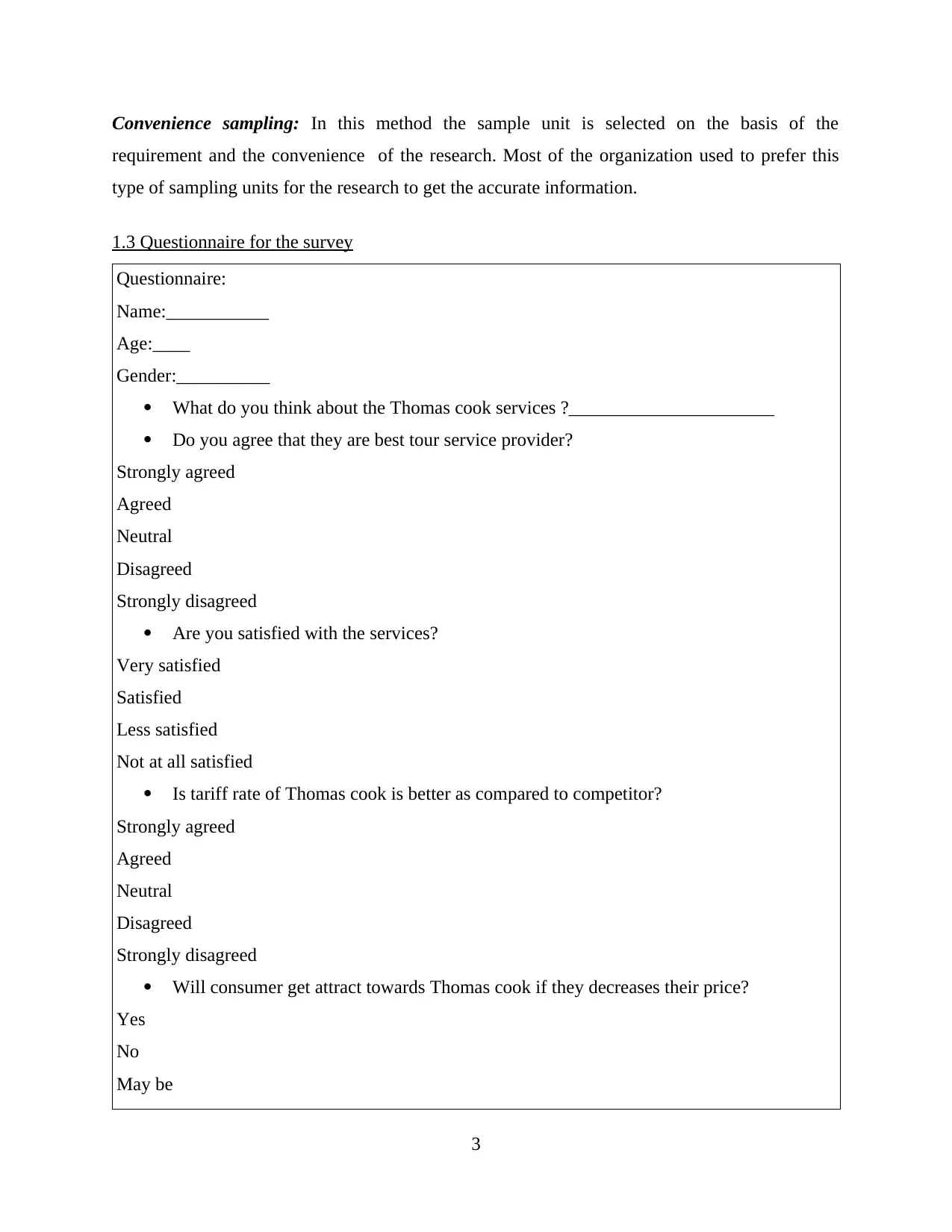
Convenience sampling: In this method the sample unit is selected on the basis of the
requirement and the convenience of the research. Most of the organization used to prefer this
type of sampling units for the research to get the accurate information.
1.3 Questionnaire for the survey
Questionnaire:
Name:___________
Age:____
Gender:__________
What do you think about the Thomas cook services ?______________________
Do you agree that they are best tour service provider?
Strongly agreed
Agreed
Neutral
Disagreed
Strongly disagreed
Are you satisfied with the services?
Very satisfied
Satisfied
Less satisfied
Not at all satisfied
Is tariff rate of Thomas cook is better as compared to competitor?
Strongly agreed
Agreed
Neutral
Disagreed
Strongly disagreed
Will consumer get attract towards Thomas cook if they decreases their price?
Yes
No
May be
3
requirement and the convenience of the research. Most of the organization used to prefer this
type of sampling units for the research to get the accurate information.
1.3 Questionnaire for the survey
Questionnaire:
Name:___________
Age:____
Gender:__________
What do you think about the Thomas cook services ?______________________
Do you agree that they are best tour service provider?
Strongly agreed
Agreed
Neutral
Disagreed
Strongly disagreed
Are you satisfied with the services?
Very satisfied
Satisfied
Less satisfied
Not at all satisfied
Is tariff rate of Thomas cook is better as compared to competitor?
Strongly agreed
Agreed
Neutral
Disagreed
Strongly disagreed
Will consumer get attract towards Thomas cook if they decreases their price?
Yes
No
May be
3
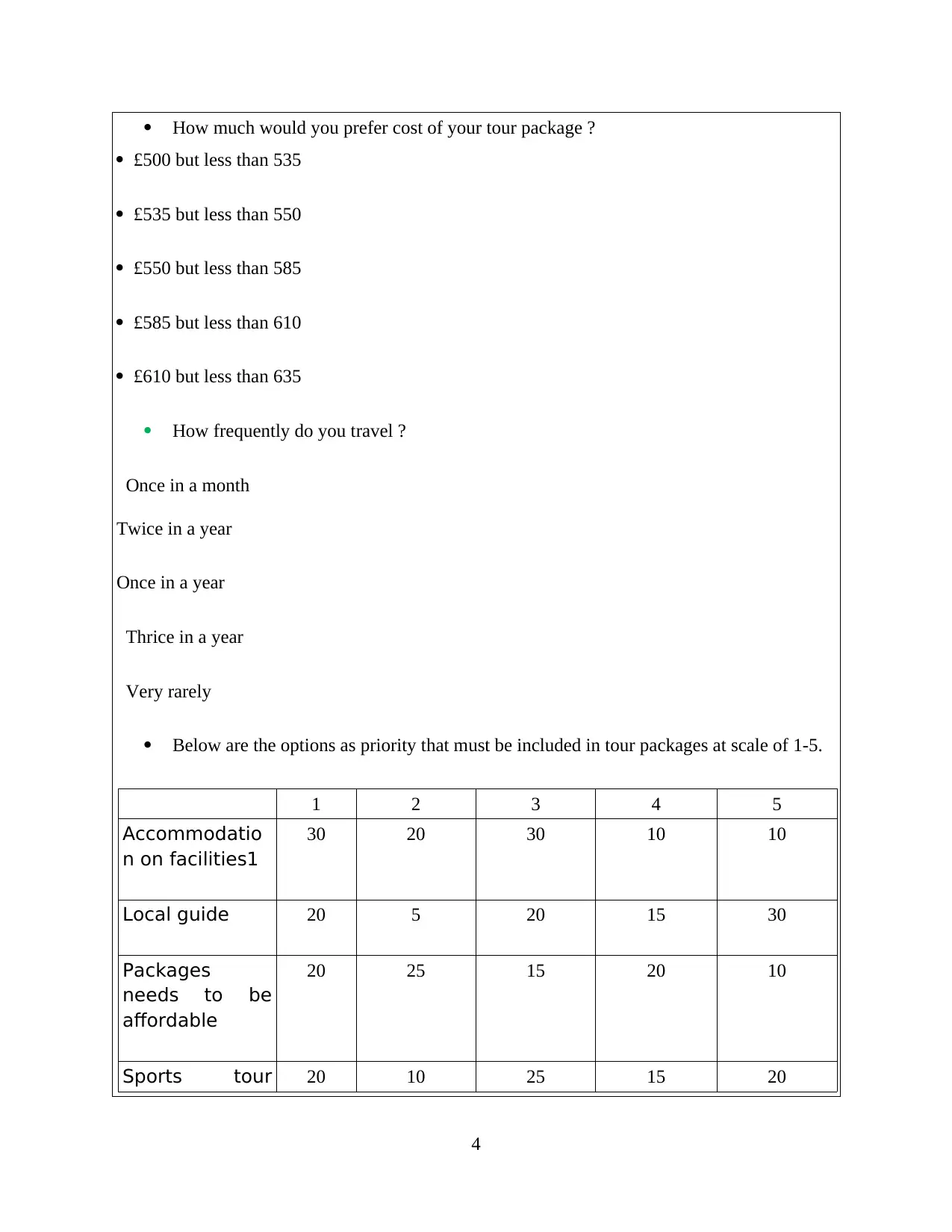
How much would you prefer cost of your tour package ?
£500 but less than 535
£535 but less than 550
£550 but less than 585
£585 but less than 610
£610 but less than 635
How frequently do you travel ?
Once in a month
Twice in a year
Once in a year
Thrice in a year
Very rarely
Below are the options as priority that must be included in tour packages at scale of 1-5.
1 2 3 4 5
Accommodatio
n on facilities1
30 20 30 10 10
Local guide 20 5 20 15 30
Packages
needs to be
affordable
20 25 15 20 10
Sports tour 20 10 25 15 20
4
£500 but less than 535
£535 but less than 550
£550 but less than 585
£585 but less than 610
£610 but less than 635
How frequently do you travel ?
Once in a month
Twice in a year
Once in a year
Thrice in a year
Very rarely
Below are the options as priority that must be included in tour packages at scale of 1-5.
1 2 3 4 5
Accommodatio
n on facilities1
30 20 30 10 10
Local guide 20 5 20 15 30
Packages
needs to be
affordable
20 25 15 20 10
Sports tour 20 10 25 15 20
4
⊘ This is a preview!⊘
Do you want full access?
Subscribe today to unlock all pages.

Trusted by 1+ million students worldwide
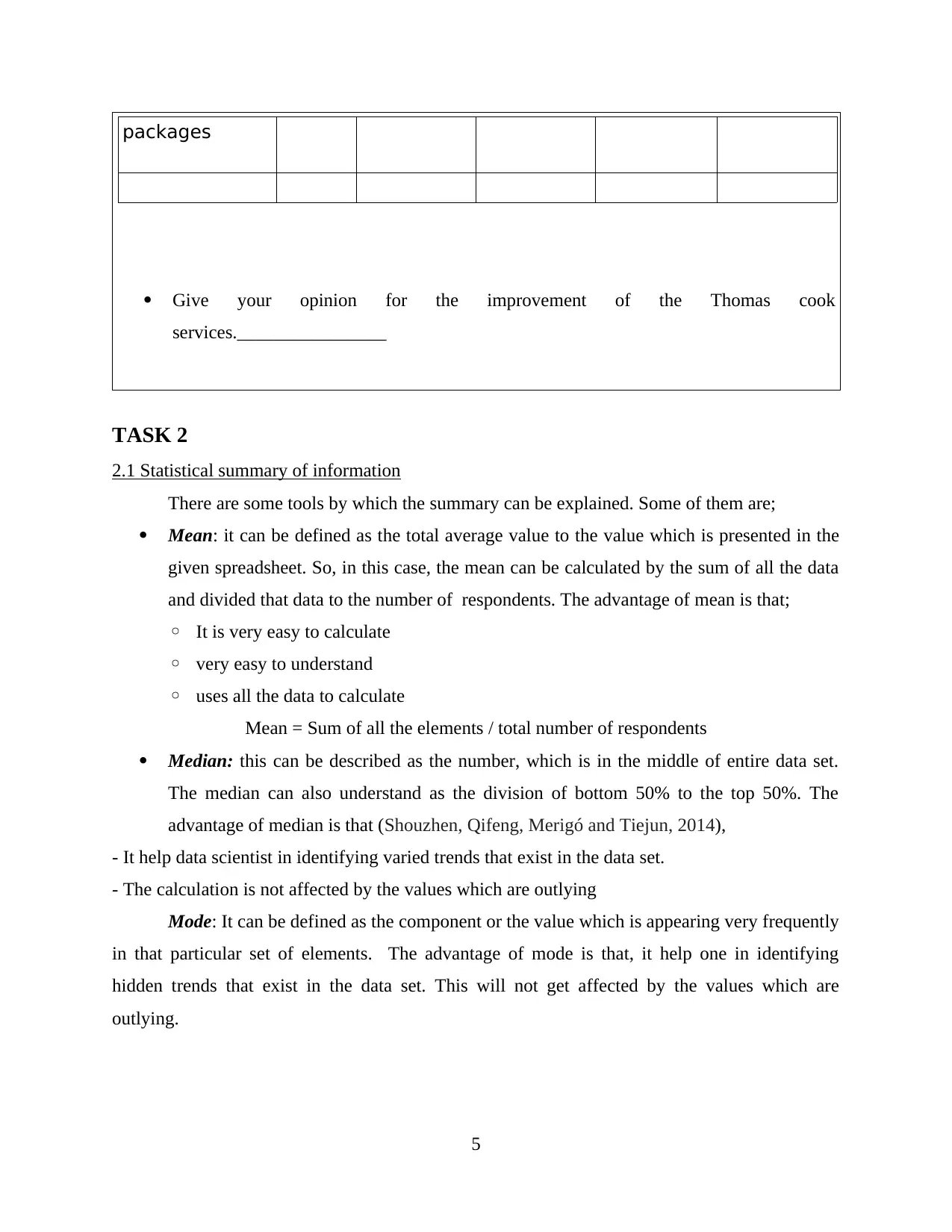
packages
Give your opinion for the improvement of the Thomas cook
services.________________
TASK 2
2.1 Statistical summary of information
There are some tools by which the summary can be explained. Some of them are;
Mean: it can be defined as the total average value to the value which is presented in the
given spreadsheet. So, in this case, the mean can be calculated by the sum of all the data
and divided that data to the number of respondents. The advantage of mean is that;
◦ It is very easy to calculate
◦ very easy to understand
◦ uses all the data to calculate
Mean = Sum of all the elements / total number of respondents
Median: this can be described as the number, which is in the middle of entire data set.
The median can also understand as the division of bottom 50% to the top 50%. The
advantage of median is that (Shouzhen, Qifeng, Merigó and Tiejun, 2014),
- It help data scientist in identifying varied trends that exist in the data set.
- The calculation is not affected by the values which are outlying
Mode: It can be defined as the component or the value which is appearing very frequently
in that particular set of elements. The advantage of mode is that, it help one in identifying
hidden trends that exist in the data set. This will not get affected by the values which are
outlying.
5
Give your opinion for the improvement of the Thomas cook
services.________________
TASK 2
2.1 Statistical summary of information
There are some tools by which the summary can be explained. Some of them are;
Mean: it can be defined as the total average value to the value which is presented in the
given spreadsheet. So, in this case, the mean can be calculated by the sum of all the data
and divided that data to the number of respondents. The advantage of mean is that;
◦ It is very easy to calculate
◦ very easy to understand
◦ uses all the data to calculate
Mean = Sum of all the elements / total number of respondents
Median: this can be described as the number, which is in the middle of entire data set.
The median can also understand as the division of bottom 50% to the top 50%. The
advantage of median is that (Shouzhen, Qifeng, Merigó and Tiejun, 2014),
- It help data scientist in identifying varied trends that exist in the data set.
- The calculation is not affected by the values which are outlying
Mode: It can be defined as the component or the value which is appearing very frequently
in that particular set of elements. The advantage of mode is that, it help one in identifying
hidden trends that exist in the data set. This will not get affected by the values which are
outlying.
5
Paraphrase This Document
Need a fresh take? Get an instant paraphrase of this document with our AI Paraphraser
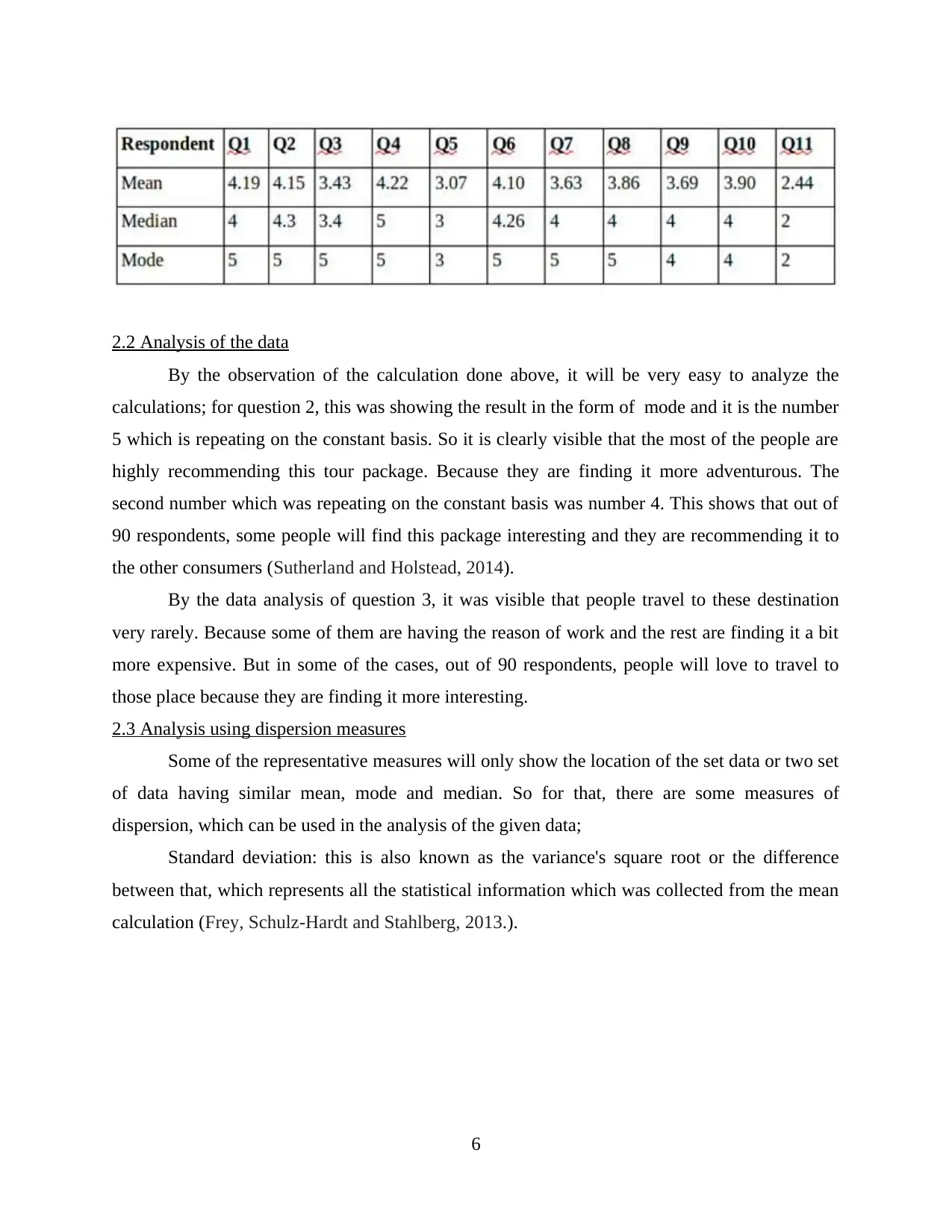
2.2 Analysis of the data
By the observation of the calculation done above, it will be very easy to analyze the
calculations; for question 2, this was showing the result in the form of mode and it is the number
5 which is repeating on the constant basis. So it is clearly visible that the most of the people are
highly recommending this tour package. Because they are finding it more adventurous. The
second number which was repeating on the constant basis was number 4. This shows that out of
90 respondents, some people will find this package interesting and they are recommending it to
the other consumers (Sutherland and Holstead, 2014).
By the data analysis of question 3, it was visible that people travel to these destination
very rarely. Because some of them are having the reason of work and the rest are finding it a bit
more expensive. But in some of the cases, out of 90 respondents, people will love to travel to
those place because they are finding it more interesting.
2.3 Analysis using dispersion measures
Some of the representative measures will only show the location of the set data or two set
of data having similar mean, mode and median. So for that, there are some measures of
dispersion, which can be used in the analysis of the given data;
Standard deviation: this is also known as the variance's square root or the difference
between that, which represents all the statistical information which was collected from the mean
calculation (Frey, Schulz-Hardt and Stahlberg, 2013.).
6
By the observation of the calculation done above, it will be very easy to analyze the
calculations; for question 2, this was showing the result in the form of mode and it is the number
5 which is repeating on the constant basis. So it is clearly visible that the most of the people are
highly recommending this tour package. Because they are finding it more adventurous. The
second number which was repeating on the constant basis was number 4. This shows that out of
90 respondents, some people will find this package interesting and they are recommending it to
the other consumers (Sutherland and Holstead, 2014).
By the data analysis of question 3, it was visible that people travel to these destination
very rarely. Because some of them are having the reason of work and the rest are finding it a bit
more expensive. But in some of the cases, out of 90 respondents, people will love to travel to
those place because they are finding it more interesting.
2.3 Analysis using dispersion measures
Some of the representative measures will only show the location of the set data or two set
of data having similar mean, mode and median. So for that, there are some measures of
dispersion, which can be used in the analysis of the given data;
Standard deviation: this is also known as the variance's square root or the difference
between that, which represents all the statistical information which was collected from the mean
calculation (Frey, Schulz-Hardt and Stahlberg, 2013.).
6
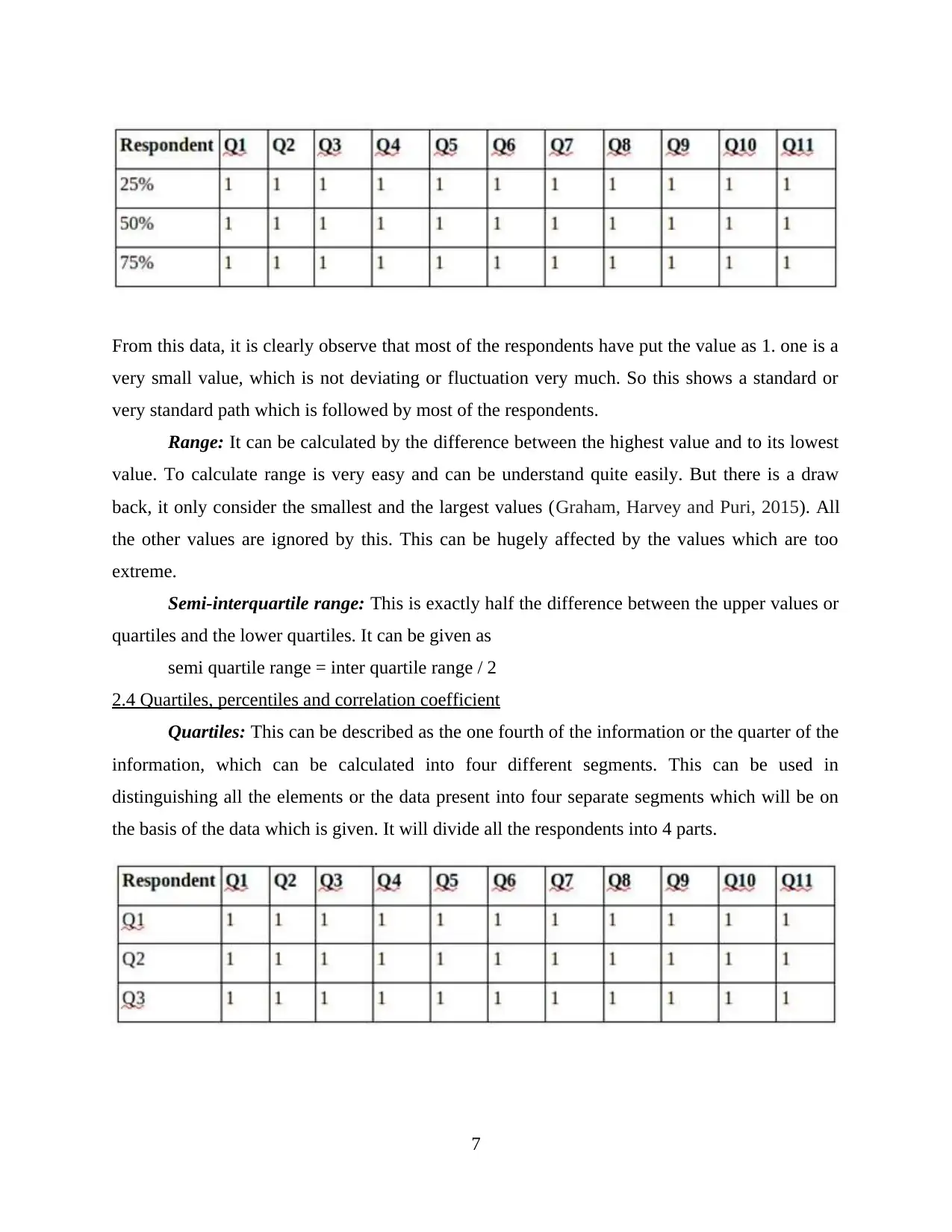
From this data, it is clearly observe that most of the respondents have put the value as 1. one is a
very small value, which is not deviating or fluctuation very much. So this shows a standard or
very standard path which is followed by most of the respondents.
Range: It can be calculated by the difference between the highest value and to its lowest
value. To calculate range is very easy and can be understand quite easily. But there is a draw
back, it only consider the smallest and the largest values (Graham, Harvey and Puri, 2015). All
the other values are ignored by this. This can be hugely affected by the values which are too
extreme.
Semi-interquartile range: This is exactly half the difference between the upper values or
quartiles and the lower quartiles. It can be given as
semi quartile range = inter quartile range / 2
2.4 Quartiles, percentiles and correlation coefficient
Quartiles: This can be described as the one fourth of the information or the quarter of the
information, which can be calculated into four different segments. This can be used in
distinguishing all the elements or the data present into four separate segments which will be on
the basis of the data which is given. It will divide all the respondents into 4 parts.
7
very small value, which is not deviating or fluctuation very much. So this shows a standard or
very standard path which is followed by most of the respondents.
Range: It can be calculated by the difference between the highest value and to its lowest
value. To calculate range is very easy and can be understand quite easily. But there is a draw
back, it only consider the smallest and the largest values (Graham, Harvey and Puri, 2015). All
the other values are ignored by this. This can be hugely affected by the values which are too
extreme.
Semi-interquartile range: This is exactly half the difference between the upper values or
quartiles and the lower quartiles. It can be given as
semi quartile range = inter quartile range / 2
2.4 Quartiles, percentiles and correlation coefficient
Quartiles: This can be described as the one fourth of the information or the quarter of the
information, which can be calculated into four different segments. This can be used in
distinguishing all the elements or the data present into four separate segments which will be on
the basis of the data which is given. It will divide all the respondents into 4 parts.
7
⊘ This is a preview!⊘
Do you want full access?
Subscribe today to unlock all pages.

Trusted by 1+ million students worldwide
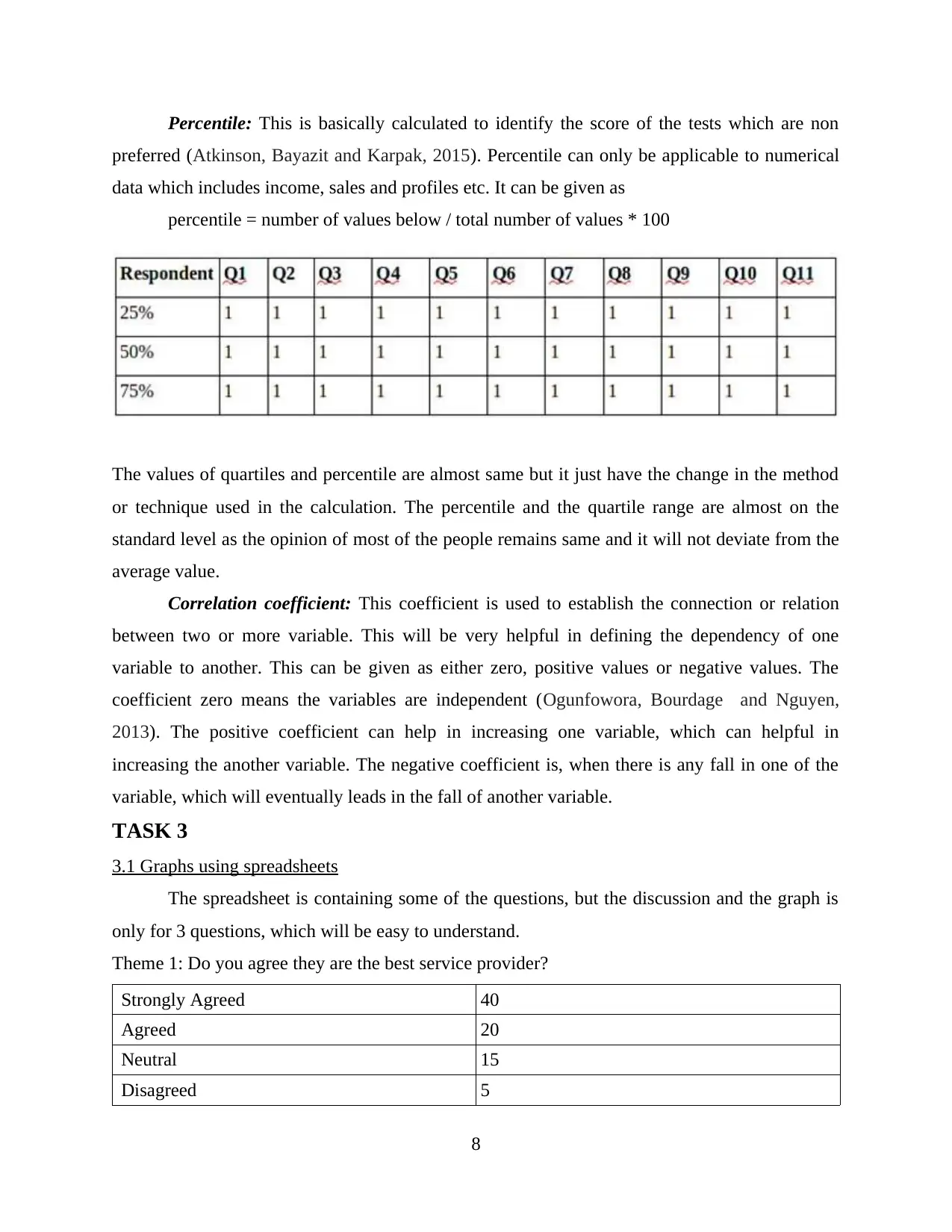
Percentile: This is basically calculated to identify the score of the tests which are non
preferred (Atkinson, Bayazit and Karpak, 2015). Percentile can only be applicable to numerical
data which includes income, sales and profiles etc. It can be given as
percentile = number of values below / total number of values * 100
The values of quartiles and percentile are almost same but it just have the change in the method
or technique used in the calculation. The percentile and the quartile range are almost on the
standard level as the opinion of most of the people remains same and it will not deviate from the
average value.
Correlation coefficient: This coefficient is used to establish the connection or relation
between two or more variable. This will be very helpful in defining the dependency of one
variable to another. This can be given as either zero, positive values or negative values. The
coefficient zero means the variables are independent (Ogunfowora, Bourdage and Nguyen,
2013). The positive coefficient can help in increasing one variable, which can helpful in
increasing the another variable. The negative coefficient is, when there is any fall in one of the
variable, which will eventually leads in the fall of another variable.
TASK 3
3.1 Graphs using spreadsheets
The spreadsheet is containing some of the questions, but the discussion and the graph is
only for 3 questions, which will be easy to understand.
Theme 1: Do you agree they are the best service provider?
Strongly Agreed 40
Agreed 20
Neutral 15
Disagreed 5
8
preferred (Atkinson, Bayazit and Karpak, 2015). Percentile can only be applicable to numerical
data which includes income, sales and profiles etc. It can be given as
percentile = number of values below / total number of values * 100
The values of quartiles and percentile are almost same but it just have the change in the method
or technique used in the calculation. The percentile and the quartile range are almost on the
standard level as the opinion of most of the people remains same and it will not deviate from the
average value.
Correlation coefficient: This coefficient is used to establish the connection or relation
between two or more variable. This will be very helpful in defining the dependency of one
variable to another. This can be given as either zero, positive values or negative values. The
coefficient zero means the variables are independent (Ogunfowora, Bourdage and Nguyen,
2013). The positive coefficient can help in increasing one variable, which can helpful in
increasing the another variable. The negative coefficient is, when there is any fall in one of the
variable, which will eventually leads in the fall of another variable.
TASK 3
3.1 Graphs using spreadsheets
The spreadsheet is containing some of the questions, but the discussion and the graph is
only for 3 questions, which will be easy to understand.
Theme 1: Do you agree they are the best service provider?
Strongly Agreed 40
Agreed 20
Neutral 15
Disagreed 5
8
Paraphrase This Document
Need a fresh take? Get an instant paraphrase of this document with our AI Paraphraser
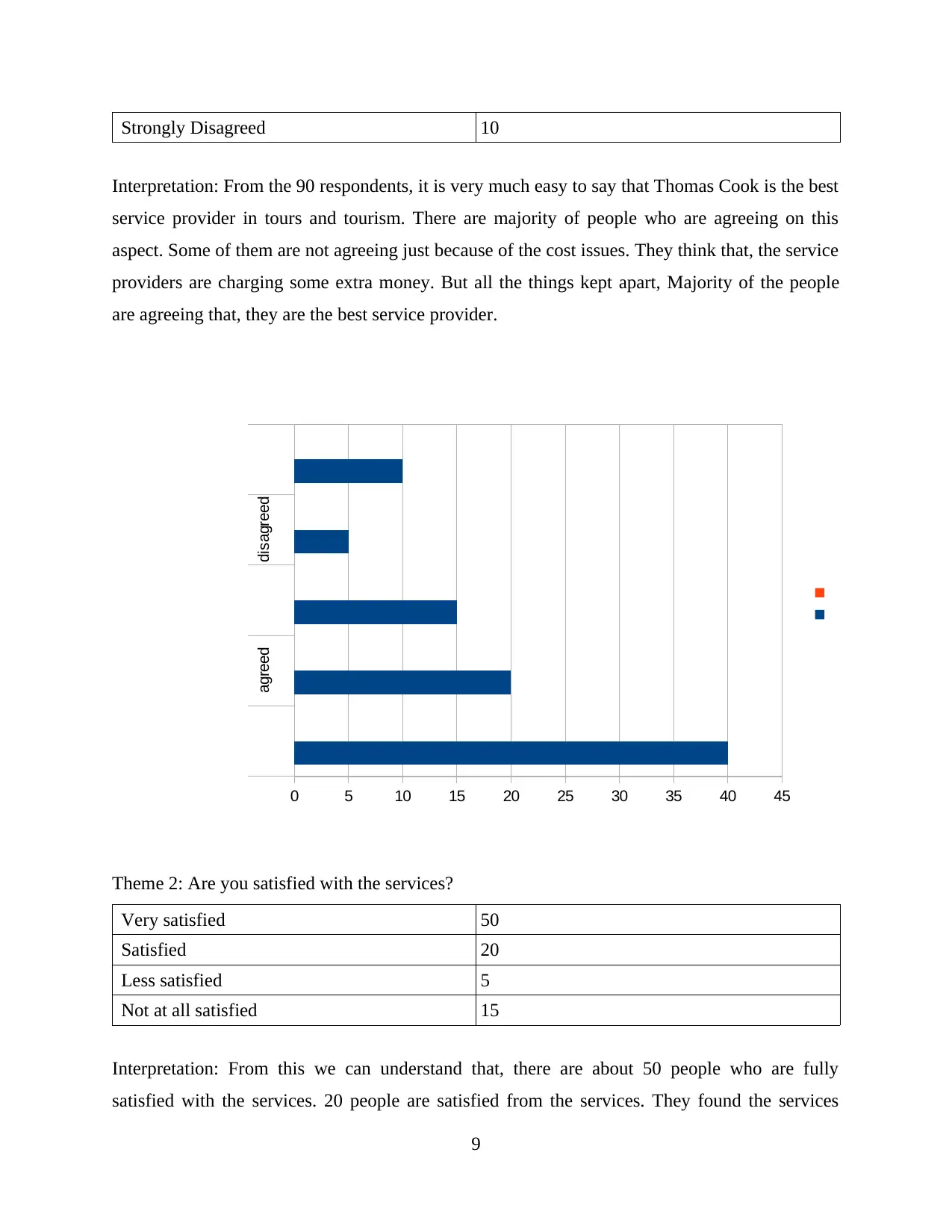
Strongly Disagreed 10
Interpretation: From the 90 respondents, it is very much easy to say that Thomas Cook is the best
service provider in tours and tourism. There are majority of people who are agreeing on this
aspect. Some of them are not agreeing just because of the cost issues. They think that, the service
providers are charging some extra money. But all the things kept apart, Majority of the people
are agreeing that, they are the best service provider.
Theme 2: Are you satisfied with the services?
Very satisfied 50
Satisfied 20
Less satisfied 5
Not at all satisfied 15
Interpretation: From this we can understand that, there are about 50 people who are fully
satisfied with the services. 20 people are satisfied from the services. They found the services
9
agreed disagreed
0 5 10 15 20 25 30 35 40 45
Interpretation: From the 90 respondents, it is very much easy to say that Thomas Cook is the best
service provider in tours and tourism. There are majority of people who are agreeing on this
aspect. Some of them are not agreeing just because of the cost issues. They think that, the service
providers are charging some extra money. But all the things kept apart, Majority of the people
are agreeing that, they are the best service provider.
Theme 2: Are you satisfied with the services?
Very satisfied 50
Satisfied 20
Less satisfied 5
Not at all satisfied 15
Interpretation: From this we can understand that, there are about 50 people who are fully
satisfied with the services. 20 people are satisfied from the services. They found the services
9
agreed disagreed
0 5 10 15 20 25 30 35 40 45
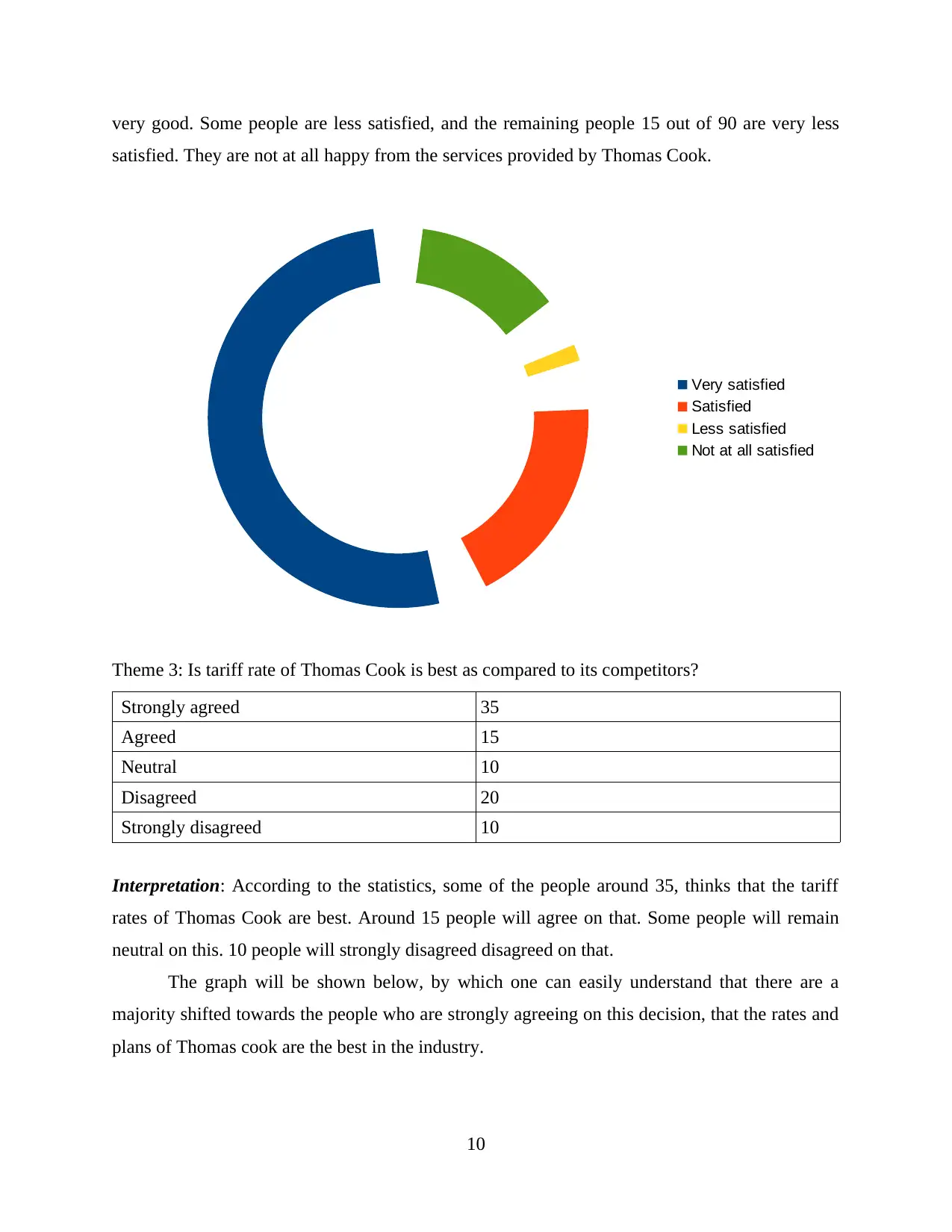
very good. Some people are less satisfied, and the remaining people 15 out of 90 are very less
satisfied. They are not at all happy from the services provided by Thomas Cook.
Theme 3: Is tariff rate of Thomas Cook is best as compared to its competitors?
Strongly agreed 35
Agreed 15
Neutral 10
Disagreed 20
Strongly disagreed 10
Interpretation: According to the statistics, some of the people around 35, thinks that the tariff
rates of Thomas Cook are best. Around 15 people will agree on that. Some people will remain
neutral on this. 10 people will strongly disagreed disagreed on that.
The graph will be shown below, by which one can easily understand that there are a
majority shifted towards the people who are strongly agreeing on this decision, that the rates and
plans of Thomas cook are the best in the industry.
10
Very satisfied
Satisfied
Less satisfied
Not at all satisfied
satisfied. They are not at all happy from the services provided by Thomas Cook.
Theme 3: Is tariff rate of Thomas Cook is best as compared to its competitors?
Strongly agreed 35
Agreed 15
Neutral 10
Disagreed 20
Strongly disagreed 10
Interpretation: According to the statistics, some of the people around 35, thinks that the tariff
rates of Thomas Cook are best. Around 15 people will agree on that. Some people will remain
neutral on this. 10 people will strongly disagreed disagreed on that.
The graph will be shown below, by which one can easily understand that there are a
majority shifted towards the people who are strongly agreeing on this decision, that the rates and
plans of Thomas cook are the best in the industry.
10
Very satisfied
Satisfied
Less satisfied
Not at all satisfied
⊘ This is a preview!⊘
Do you want full access?
Subscribe today to unlock all pages.

Trusted by 1+ million students worldwide
1 out of 20
Related Documents
Your All-in-One AI-Powered Toolkit for Academic Success.
+13062052269
info@desklib.com
Available 24*7 on WhatsApp / Email
![[object Object]](/_next/static/media/star-bottom.7253800d.svg)
Unlock your academic potential
Copyright © 2020–2025 A2Z Services. All Rights Reserved. Developed and managed by ZUCOL.





